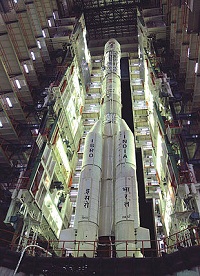-

Most rockets take about nine minutes to put their payloads into low Earth orbit, going from a dead stop on terra firma to 17,500 miles per hour.
In the case of India’s GSLV rocket, it takes several years longer. That’s the typical interval between launch attempts. You then have to add on a couple of more years to account for all of the GSLV’s launch failures. Of seven launches over nearly 12 years, India’s largest rocket has notched only two successes and one partial success. The last fully successful flight occurred in September 2004.
But, ISRO is, if nothing else,doggedly persistent. In April, the Indian space agency will attempt to launch a GSLV rocket fitted with its second domestically produced cryogenic upper stage. The launch will take place exactly three years after the turbo pump on the first homemade cryogenic engine malfunctioned, sending the GSAT-4 communications satellite into the Bay of Bengal. That failure came after 17 years of work on cryogenic technology.
April’s flight will also take place 2 years and 4 months after the most recent GSLV launch attempt. On Christmas Day 2010, the range safety officer blew up the rocket, which was equipped with a Russian-made upper stage, after the first stage veered off course. That failure sent the GSAT-5P satellite to a watery grave.
P.S. Veeraraghava, director of the Vikram Sarabhai Space Centre (VSSC), says engineers have fixed the problems with the cryogenic upper stage and are ready to try again by launching GSAT-6.
“Most of the systems for the launch are ready and we are now into the final leg of certain tests, which will validate the mission involving indigenous cryogenic engine,” Veeraraghavan told reporters on the sidelines of a seminar on ‘Aerospace and related mechanisms’ here on Thursday. The Thiruvananthapuram-based VSSC is the lead centre of ISRO for development of satellite launch vehicles and associated technologies….
“We did a thorough analysis of the D3 flight and identified the reasons behind its failure,” Veeraraghavan said. “The analysis called for a redesign of certain components in the cryogenic propulsion system and the same has now been addressed and is being put through multiple testing,” he said.
“Most tests have been completed except for the high altitude test, which validates the mission of our cryogenic engine. We hope to complete this and launch the GSLV mission by April 2013,” Veeraraghavan said…
“The VSSC is working on the next variant of GSLV Mark III launch vehicles that will make India totally self-reliant in the area of launch vehicles, Veeraraghavan said. The centre is further working on development of resusable launch vehicles that can deliver a spacecraft into the orbit and return for a repeat use. This will bring down the cost of space transport.”
The GSLV Mark III is capable of launching payloads of up to 10,000 kg .(22,000 lbs.) into low Earth orbit. The current GSLV Mark II is capable of launching around 5,000 kg. (11,000 lbs.) into orbit. The GSLV Mark III is not derived from the same technology as the smaller rocket.
Quelle: ISRO
5321 Views

